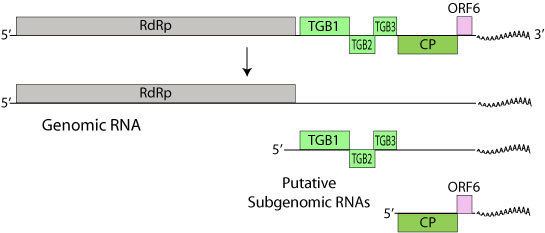Group Group IV ((+)ssRNA) Rank Genus | ||
 | ||
Similar Potexvirus, Potato virus M, Cowpea mild mottle virus, Potyvirus, Potato virus X | ||
Medical vocabulary what does carlavirus mean
Carlavirus, formerly known as the "Carnation latent virus group", is a genus of viruses in the order Tymovirales, in the family Betaflexiviridae. Plants serve as natural hosts. There are currently 52 species in this genus including the type species Carnation latent virus. Diseases associated with this genus include: mosaic and ringspot symptoms.
Contents
- Medical vocabulary what does carlavirus mean
- Description
- Taxonomy
- Virology
- Life Cycle
- Transmission
- References
Description
Carlavirus is described in the 9th report of the ICTV (2009). The genus is characterised by having six ORFs (Open Reading Frames) including a TGB (Triple Gene Block). The viruses are transmitted by insects.
Taxonomy
The genus was first proposed in the first report of the ICTV in 1971, as the 'Carnation latent virus group' but was renamed in 1975 as the 'Carlavirus Group', and as the genus Carlavirus in 1995 (6th report). In 2005 (8th report) it was placed in the Flexiviridae family, having previously been unassigned. The current position in the 9th report (2009) as a genus of the Betaflexiviridae family derives from the subsequent subdivision of Flexiviridae.
As of the 2014 release of the ICTV database, there are currently 52 virus species included in this genus. The type species is the Carnation latent virus.
Group: ssRNA(+)
Virology
The virions are non enveloped, filamentous, 610–700 nanometers (nm) and 12–15 nm in diameter.
The linear 5.8–9 kilobase genome is positive sense, single-stranded RNA. The 3’ terminus is polyadenylated. In some species the 5’ end is capped. The genome encodes 3 to 6 proteins including a coat protein located at the 3' end and an RNA-dependent RNA polymerase located at the 5' end of the genome.
Life Cycle
Viral replication is cytoplasmic, and is lysogenic. Entry into the host cell is achieved by penetration into the host cell. Replication follows the positive stranded RNA virus replication model. Positive stranded RNA virus transcription is the method of transcription. The virus exits the host cell by tripartite non-tubule guided viral movement. Plants serve as the natural host.
Transmission
Infection is at times spread by aphids in a semi-persistent mode, that is, the vector is infective for a number of hours.(Pimentel) Some species are transmitted by Bemisia tabaci in a semi-persistent mode or through the seed. Most species infect only a few hosts and cause infections with few or no symptoms, for example, American hop latent virus and lily symptomless virus. Some, such as blueberry scorch virus and poplar mosaic virus, cause serious illnesses. (Foster)
